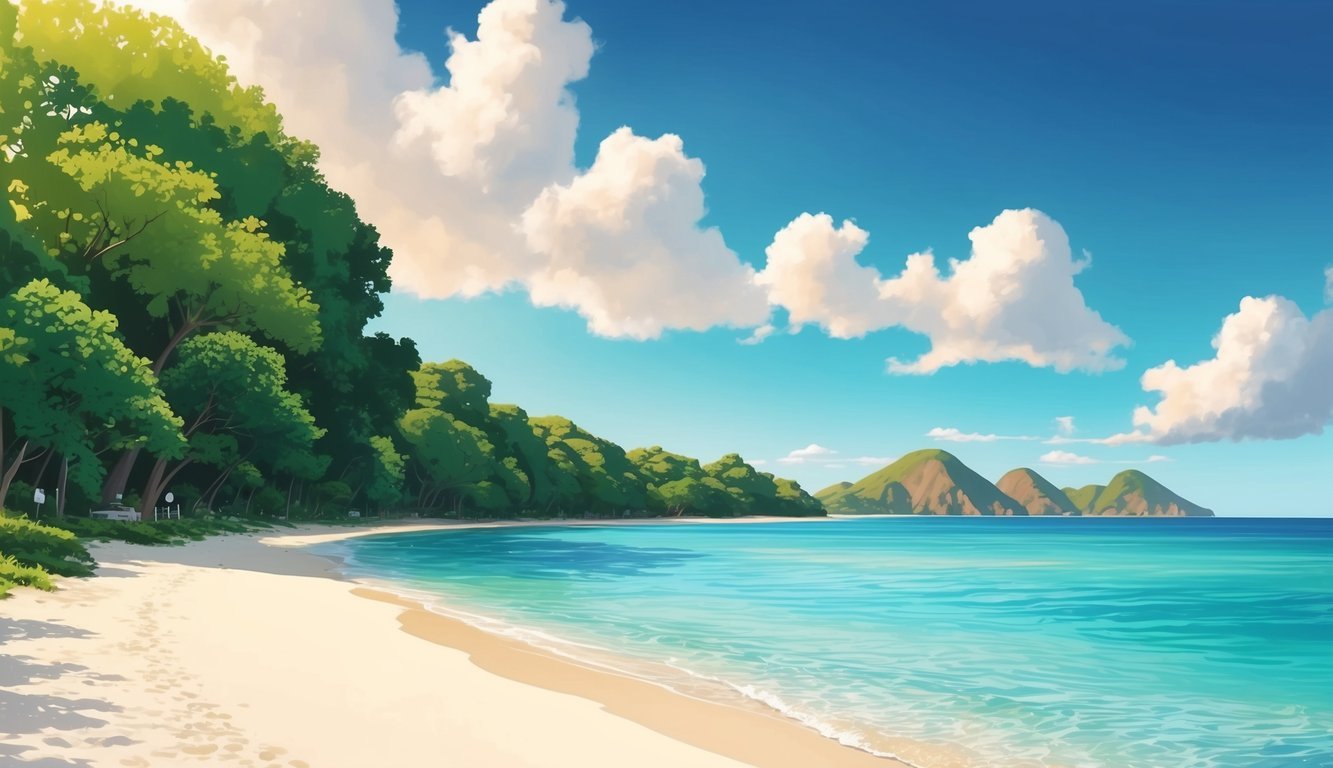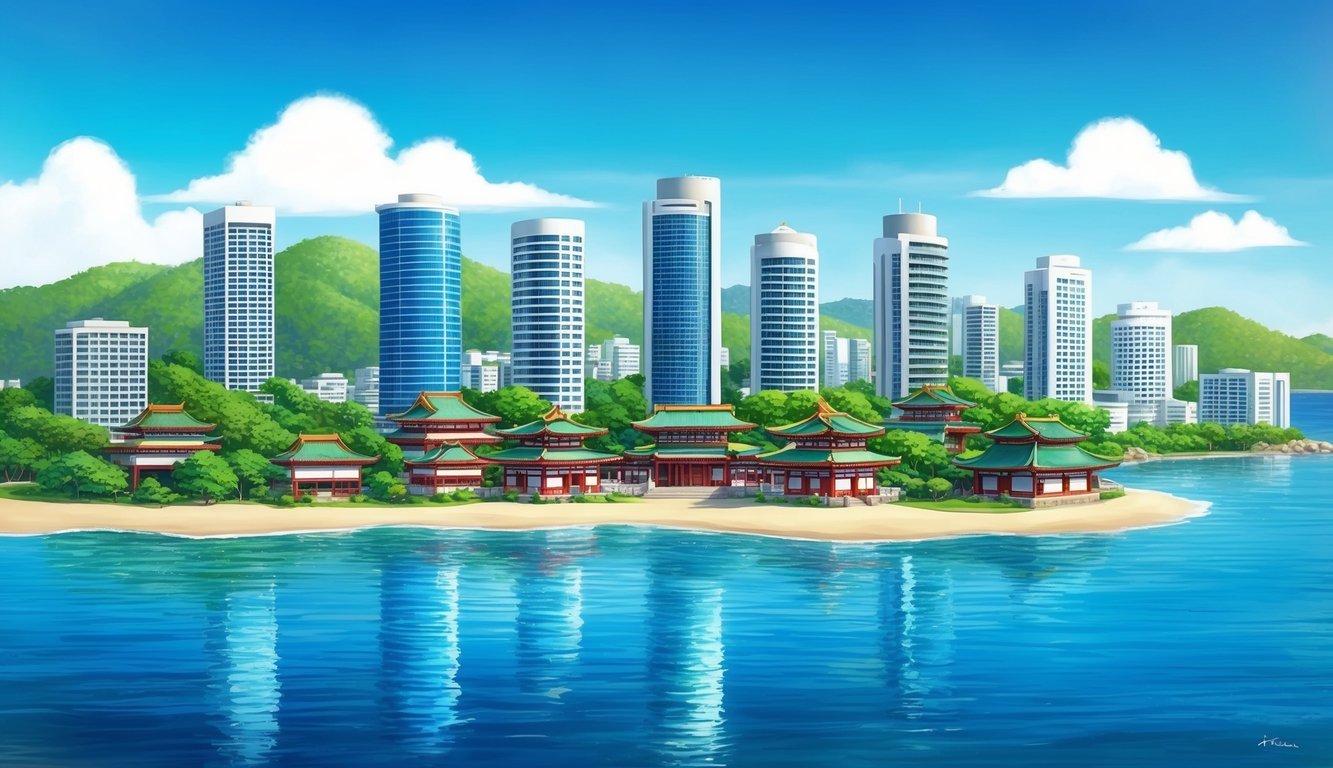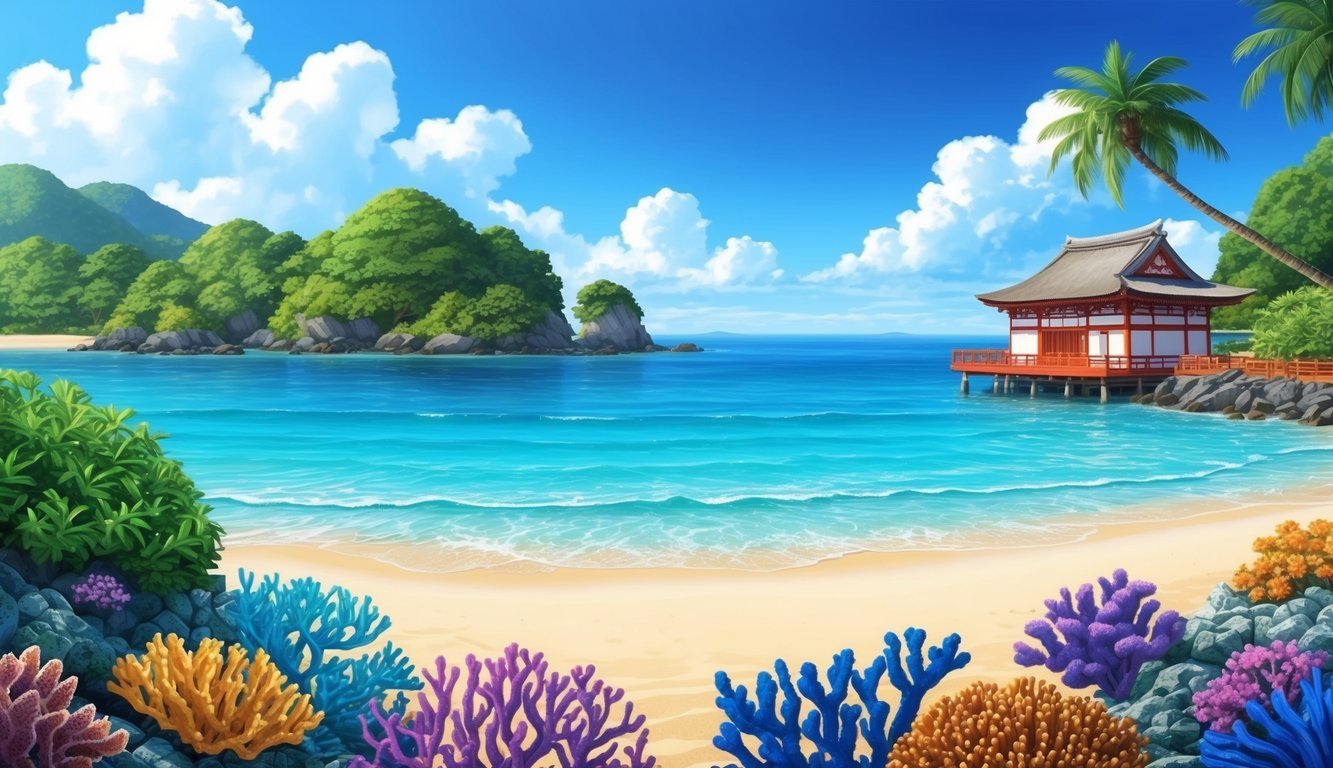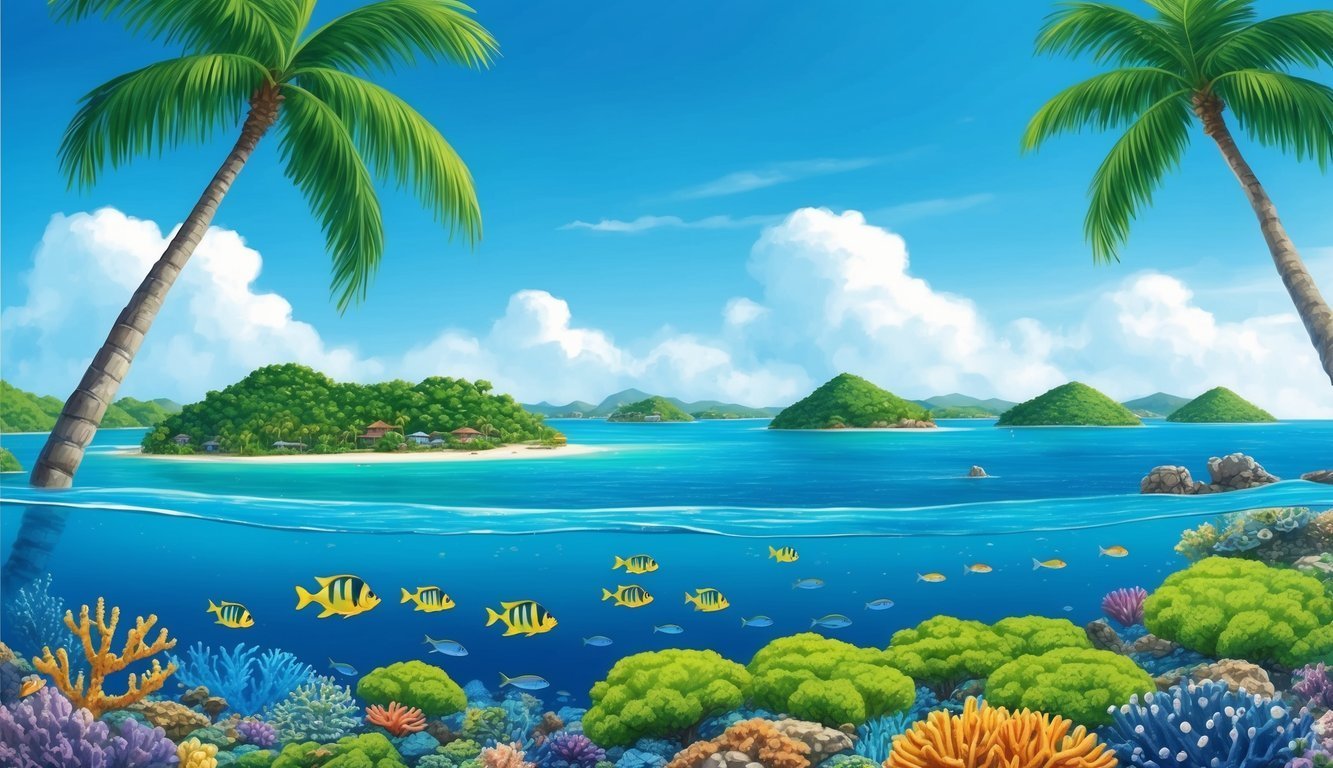Okinawa, Japan, is a stunning destination known for its beautiful beaches, rich culture, and warm climate. Okinawa offers visitors an experience like no other in Japan, with its unique blend of history and modern life.
From crystal-clear waters to vibrant festivals, there’s something for everyone to enjoy.

As you explore this tropical paradise, you will discover its fascinating past and how it has shaped the local lifestyle.
Okinawa’s diverse cuisine, traditional crafts, and distinct art forms reflect a heritage that is both unique and inviting.
You’ll also find plenty of outdoor activities, making it an excellent spot for adventure seekers and relaxation alike.
Whether you’re interested in lounging on the beach, indulging in local foods, or learning about the culture, Okinawa has it all.
Plan your trip to experience the magic of this remarkable island.
Key Takeaways
- Okinawa is known for its beautiful beaches and unique cultural heritage.
- The island offers a mix of historical sites and modern attractions.
- There are many activities available for both relaxation and adventure.
Okinawa Overview

Okinawa, located in Japan, is a beautiful prefecture known for its stunning islands and unique culture.
It includes more than 160 islands, with the largest being Okinawa Main Island (沖縄本島).
The population of Okinawa is around 1.4 million people.
This diverse group reflects a mix of influences from both Japan and surrounding regions.
The capital city, Naha, is found on Okinawa Main Island and serves as a hub for travelers.
You will discover that Okinawa has a distinct history.
Once a semi-independent kingdom, it faced significant challenges during World War II.
Today, it blends ancient traditions with modern life, making it a fascinating place to visit.
The climate here is subtropical, which means you can expect warm temperatures year-round.
This makes Okinawa perfect for outdoor activities like snorkeling, diving, and hiking.
Okinawa’s coastal spots are famous for their clear blue water and coral reefs.
The islands are also known for delicious local dishes, especially seafood and unique Okinawan cuisine.
When planning your visit, consider exploring both popular attractions and hidden gems.
From beautiful beaches to historic sites, Okinawa offers a bit of everything, ensuring a memorable experience.
Geography and Climate
Okinawa, an island paradise located in the East China Sea, boasts stunning landscapes and a unique subtropical climate.
You’ll find a mix of beautiful beaches, coral reefs, and diverse ecosystems across its main island and surrounding smaller islands.
Main Island and Remote Islands
The main island of Okinawa is surrounded by several smaller islands, each with its own charm.
The Yaeyama Islands include Ishigaki Island, Iriomote Island, and Yonaguni, known for their beaches and rich marine life.
Miyako Island and the Miyako Islands group feature pristine waters and vibrant coral reefs.
To the west, the Kerama Islands offer stunning diving spots.
Each island provides a slice of paradise, whether you seek adventure or relaxation amid crystal-clear waters and unique flora and fauna.
Natural Beauty and Diversity
Okinawa’s natural beauty is breathtaking.
The Yanbaru area in the north is a dense forest home to diverse wildlife, including rare species like the Okinawa rail.
The coastline features coral reefs that are among the healthiest in the world.
You can enjoy various activities, such as snorkeling and diving, to explore this vibrant underwater ecosystem.
The islands are also known for their stunning sunsets and lush green mountains, making them perfect for nature lovers and photographers alike.
Environmental Conditions
Okinawa experiences a humid subtropical climate, which means summers are hot and humid.
The rainy season typically occurs from May to June, when you can expect heavy rainfall.
Typhoons can hit between August and October, so plan your trip accordingly.
Winters are mild, with average temperatures dropping to around 56°F (13°C) in January.
This pleasant climate allows for year-round tourism, with visitors flocking to enjoy the island’s warm temperatures and outdoor activities, regardless of the season.
History and Heritage
Okinawa has a rich history shaped by its unique culture, conflicts, and heritage sites.
From its time as the Ryukyu Kingdom to the impacts of World War II, understanding this background enhances your visit to the islands.
Rich Past of the Ryukyu Kingdom
The Ryukyu Kingdom was established in 1429 and thrived for over 400 years.
This kingdom was a hub for trade and culture, connecting Japan, China, and Southeast Asia.
The capital was located in Shuri, where you can find the famous Shuri Castle.
This castle was the royal palace and showcases beautiful architecture that reflects the kingdom’s cultural influences.
During the Gusuku Period, many castle ruins were built.
These castles, like Nakagusuku Castle and Nakijin Castle, are now popular heritage sites.
They represent the architectural skills and governance of the Ryukyu Kingdom.
You can explore these sites and learn about the kingdom’s vibrant history.
World War II Impact
World War II had a profound effect on Okinawa, especially during the Battle of Okinawa in 1945.
This battle was one of the bloodiest in the Pacific and resulted in significant destruction and loss of life.
The war left lasting scars on the land and its people.
After the war, many areas were rebuilt, but the history remains visible.
Visiting the Cornerstone of Peace memorial offers a chance to reflect on the tragedy and resilience of the Okinawan people.
This memorial honors all who lost their lives during the battle and promotes peace.
Historical Sites and Monuments
Okinawa is home to numerous historical sites and monuments that tell the story of its past.
The Gusuku Sites and Related Properties of the Kingdom of Ryukyu have been recognized as a UNESCO World Heritage Site.
These locations include impressive castle ruins and sacred grounds.
As you explore, you’ll encounter various monuments that represent Okinawa’s unique cultural blend.
Each site provides insight into the island’s history, making it easy to appreciate the rich heritage that shapes Okinawa today.
Be sure to visit both the scenic ruins and meaningful memorials to fully experience Okinawa’s legacy.
Culture and Lifestyle
Okinawa’s culture and lifestyle are rich with unique traditions, food, music, and crafts.
These elements reflect the island’s historical significance and the influences from its past as the independent Ryukyu Kingdom.
Okinawan Culture and Traditions
Okinawa boasts a distinct culture rooted in its history and geography.
The Ryukyuan people have unique customs, which include the practice of karate, a martial art that emphasizes self-discipline and physical fitness.
You’ll find various festivals throughout the year that celebrate local traditions.
The Okinawa Soba noodles are a staple food, often enjoyed during these celebrations.
Okinawans are known for their longevity, and many attribute it to their active lifestyle and healthy diet rich in vegetables and seafood.
Music and Dance
Music and dance are integral to Okinawan culture.
The sanshin, a traditional stringed instrument, is often used to create vibrant tunes.
Local performers play this instrument at festivals and events, bringing a joyful atmosphere.
Eisa is a traditional dance performed during the Obon festival, celebrating ancestors.
It involves lively drumming and colorful costumes, reflecting the island’s spirit and communal bonds.
Whether you’re watching a performance or joining in, you’ll feel the rhythm of Okinawa.
Local Crafts and Cuisine
Okinawa is famous for its beautiful handicrafts. Bingata, a traditional dyeing technique, produces vibrant fabrics used in clothing and décor.
You can find unique souvenirs that showcase this skill in local shops.
The local cuisine is another highlight.
You must try awamori, a traditional rice liquor that adds a unique flavor to your meals.
Pair it with dishes like Okinawa Soba for an authentic gastronomic experience.
Exploring local markets will give you a taste of the island’s rich culinary heritage.
Tourist Attractions and Activities
Okinawa offers a diverse range of attractions and activities that allow you to explore rich history, enjoy breathtaking nature, and experience vibrant local culture.
From famous landmarks to thrilling adventures, there’s something for everyone.
Landmarks and Parks
One of the must-visit landmarks is Shuri Castle in Naha.
This UNESCO World Heritage site was once the center of the Ryukyu Kingdom.
Strolling through its ancient walls gives you a glimpse into Okinawa’s royal history.
Another highlight is the Okinawa Churaumi Aquarium.
It features massive tanks showcasing the region’s marine life, including whale sharks and manta rays.
Located in Ocean Expo Park, it’s a perfect spot for family fun and education.
You also shouldn’t miss Cape Manzamo.
This scenic area boasts stunning coastal views and unique rock formations.
It’s ideal for some memorable photos, especially during sunset.
Adventure and Recreation
For the adventurous at heart, Okinawa is a paradise. Diving and snorkeling are popular activities thanks to the clear waters and vibrant coral reefs.
You can explore underwater life at spots like the Kerama Islands.
If you’re interested in something less intense, the American Village offers shopping, dining, and entertainment.
Here, you can find unique souvenirs and enjoy local foods in an upbeat atmosphere.
You might also want to visit Okinawa World.
This theme park showcases traditional crafts, caves, and even an underground river.
It’s a fun way to learn about Okinawa’s culture while trying local delicacies.
Festivals and Events
Okinawa is vibrant with festivals throughout the year.
The Shuri Castle Festival celebrates the heritage of the Ryukyu Kingdom with parades, traditional dances, and food stalls.
It’s an exciting time to immerse yourself in local culture.
Cherry blossom season is another highlight.
The blooming sakura attracts visitors to parks for picnics and sightseeing.
You can experience the unique blend of nature and tradition during this beautiful time.
Other events include local markets and food festivals.
They provide a chance to taste fresh produce and traditional dishes while enjoying live performances.
It’s a great way to feel the spirit of Okinawa.
Transportation and Access
Getting around Okinawa is straightforward, making it easy for you to explore the beautiful islands.
From reaching the main island to navigating local transportation options, you have several choices to suit your needs.
Navigating to and on the Island
You’ll likely arrive at Naha Airport, the main gateway to Okinawa.
This airport handles many international flights, connecting you to various cities worldwide.
Once you land, you can easily head to your destination.
On the main island, travel between inhabited islands like Ishigaki, Kumejima, Taketomi, and Irabu is commonly done via ferries and short flights.
Local airlines provide regular flights to these islands.
The journey is scenic and gives you glimpses of the stunning ocean views.
Local Transportation
Moving around the island is convenient.
Naha has a modern monorail system known as Yui Rail, which links the airport with key areas in the city.
Public buses serve the main island, connecting popular spots with frequent routes.
Consider purchasing a limited-area pass for easy access to the bus network.
Taxis are available as well, just remember that they can be pricey.
For a more adventurous experience, consider renting a car, bicycle, or scooter.
This allows you to explore at your own pace, especially in more rural areas.
Each option gives you the freedom to discover the unique charm of Okinawa.
Modern Okinawa

Okinawa today is a blend of rich culture and significant military presence.
The island is home to a diverse population and plays an essential role in U.S.-Japan relations due in large part to the U.S. military bases located there.
Demographics and Society
Modern Okinawa has a unique demographic makeup.
Most residents are ethnically Okinawan, with many being of mixed Japanese heritage.
The population is about 1.4 million, making it a vibrant and bustling place.
The island is often recognized for its high number of centenarians, partly due to a healthy diet and active lifestyle.
Social connections are strong in Okinawa, with community ties playing a significant role in daily life.
You might also notice that Okinawa has a blend of traditional Ryukyuan culture and more contemporary Japanese influences.
Festivals, cuisine, and local customs showcase this rich mix.
Military Presence and Relations
Okinawa hosts a substantial U.S. military presence, with numerous bases such as Kadena Air Base.
This base is one of the largest U.S. Air Force bases in Asia and serves as a critical hub for military operations.
The relationship between the U.S. military and Okinawans is complex.
While many locals appreciate the economic benefits, others express concerns over noise, pollution, and crime related to the bases.
Around 25,000 U.S. military personnel are stationed in Okinawa, influencing the local economy and culture.
In recent years, there have been efforts to reduce the footprint of U.S. forces, leading to the return of land, such as the 10,000 acres returned in 2016, marking significant changes in military relations.
Guides and Recommendations

When planning your trip to Okinawa, finding the right resources and local insights can enhance your experience.
This section will help you navigate travel guides and uncover unique local activities.
Travel Guides and Resources
A range of travel guides are available to help you explore Okinawa.
Websites like Visit Okinawa Japan offer detailed information on must-see attractions.
You can find suggestions for activities like kayaking along the stunning coastlines.
Local travel apps can also be helpful for real-time updates on events and weather.
Use these to follow local news for any activities during your visit.
Besides digital resources, consider picking up a physical guidebook.
These often include maps, cultural insights, and off-the-beaten-path suggestions.
Local Insights
For an authentic Okinawa experience, dive into local culture and activities.
Engage with locals to learn about satsuma, a traditional sweet potato dish, which you can find in many local markets.
Don’t miss out on the remote islands, such as Miyako and Ishigaki, which are known for their unparalleled beauty.
Consider renting a kayak for a day to explore these hidden gems from the water.
Local festivals and performances showcase Okinawa’s unique heritage.
Try to align your visit with events like the Eisa Festival for a taste of local music and dance.
Always keep an eye out for local artisans and markets to bring home unique souvenirs.
Frequently Asked Questions

When planning your trip to Okinawa, you might have some specific questions.
Here are the answers to common inquiries that travelers often have about this unique island.
What is Okinawa famous for?
Okinawa is known for its stunning beaches, clear blue waters, and vibrant coral reefs.
It’s a top destination for snorkeling, diving, and other water sports.
The island also boasts a rich history with ancient castles and a distinct cuisine that includes local specialties, like Okinawan soba.
What makes Okinawa a ‘blue zone’ and why does it matter?
Okinawa is classified as a “blue zone” because its residents have one of the highest life expectancies in the world.
Factors such as a healthy diet, strong social connections, and an active lifestyle contribute to this phenomenon.
Understanding these aspects can inspire you to adopt similar habits for a healthier life.
How does Okinawa’s culture differ from mainland Japan’s?
Okinawa has a unique culture that blends influences from Japan, China, and the United States.
Its traditional music, dance, and festivals reflect this rich heritage.
Additionally, the local dialect and customs can vary significantly from those found on the Japanese mainland.
What are the top attractions to visit when traveling to Okinawa?
Some must-see attractions include Shuri Castle, the Okinawa Churaumi Aquarium, and the beautiful beaches like Emerald Beach and Naminoue Beach.
You can also explore the stunning natural parks and historical sites that showcase the island’s heritage and beauty.
Is Okinawa still under the United States jurisdiction, and how does it impact travelers?
Okinawa is under Japanese sovereignty but hosts a significant U.S. military presence.
This does not majorly affect travelers, as you will experience Japan’s hospitality, culture, and laws.
However, you may notice some American influences in certain areas.
How does the population of Okinawa compare with other regions in Japan?
Okinawa has a lower population density compared to many major cities in Japan.
Yet, it has a rich community spirit and is known for its friendly locals.
This contrast can offer a more relaxed and laid-back experience during your visit.

